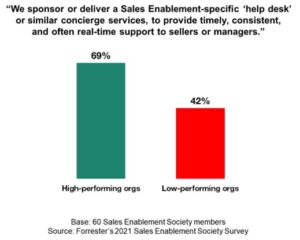Why Aren’t There More Enablement Help Desks?
There is no corner of our economy in which customer service is not universally recognized as a table-stakes priority for any organization that has … customers. The IRS stands out as the only institution I can think of that doesn’t need to care about those who use its services; for the rest of us, customer success is lifeblood. If you run a B2B revenue enablement team of any kind, I hereby challenge you to disagree with the assertion that the sales team — and all other customer-facing roles you support — are, in fact, your customers.
Why, then, are the common standards of customer care — “the customer is always right,” “we’re here for you 24×7,” “customer obsession is blah blah” — not universally applied to B2B enablement environments? Our research shows that only 45% of enablement leaders are active in doing so, although high-performing organizations are 64% more likely than low performers:

What does a help desk, or similar functionality, look like for enablement teams? Key to this sales advocacy deliverable:
- It is not always about having the answers but about the ability to find them.
- It requires deep understanding of internal (and sometimes external) resources.
- It ideally is staffed by former sellers within the organization or other insiders who are well versed in and well networked with these resources.
- It should be scalable for key moments of customer need (e.g., end of quarter, right after sales kickoff).
- It always includes a service-level agreement (SLA): How long until we guarantee a response?
Here are some ideas that can be tailored to the breadth, scope, and resources of any B2B organization:
Level 1: A Really Good Self-Service Resource Site That People Actually Use — Always On
Availability: 24 hours, 365 days
Does anyone truly love SharePoint? Whether your team uses a general corporate tool or (as we recommend) a sales-specific content solution, ensuring that the taxonomy, governance, and search capabilities are top-notch are no longer luxuries for enablement-owned technology remits. We could publish entire blogs about best practices for sales content maintenance, but on this topic, you know who you are, and what you need to do.
Level 2: Dedicated Email Address — Business Hours
Availability: 8–12 hours, workdays
How hard would it be to set up an “enablement@company.com” email account, staffed on a rotating basis by enablers who can respond to one-off queries, direct folks to the Really Good Self-Service Resource Site link that eluded them, and actually communicate directly with their internal customers? With a reasonable SLA in hand — for example, “all questions will be answered within four business hours, from 9 a.m. EST to 5 p.m. PST weekdays” — this is a great first line of defense that can also be used to continuously refine FAQs to drive enablement efficiency. It’s also a wonderful opportunity to gain insight, feedback, and intelligence from colleagues on the front lines.
Level 2a: Dedicated Email Address — Extended Hours
Availability: 13–24 hours, workdays
Same as above, but for global organizations, an opportunity to expand to round-the-clock support.
Level 3: Live Help Desk/Chat — Business Hours
Availability: 8–12 hours, workdays
With scale comes opportunity: Larger enablement teams can up the stakes — as well as the recognized value to the field — of a dedicated email address to real-time support via chat functionality, which could also be flexed to offer optional voice/video conversation (at the discretion of enablement, not field staff). This solution is high-reward, high-risk: It has the potential to be incredibly helpful but also to drown enablement with “give someone a fish” moments. A cautiously managed pilot for this level of support should be tested for effectiveness and efficiency before general roll-out. Real-time support should also explicitly be allowed to off-ramp certain requests to a lower level of assistance, such as when “we can help you but need some time to find the answer.”
Level 3a: Live Help Desk/Chat — Extended Hours
Availability: 13–24 hours, workdays
Same as above, but for global organizations, an opportunity to expand to round-the-clock support.
Level 4: AI Bot — Always On
Availability: 24 hours, 365 days
Without going down the rabbit hole of ChatGPT sentience, there are already plenty of general-purpose chat offerings for business- and consumer-oriented guided help experiences, and a few enablement-specific products are starting to emerge. This highest level of enablement advocacy requires significant upfront effort to develop, learn, and refine each organization’s knowledge base, so larger enterprises are the most likely companies to make and leverage the investment. It must have off-ramps to other assistive options, to avoid becoming ignored.
